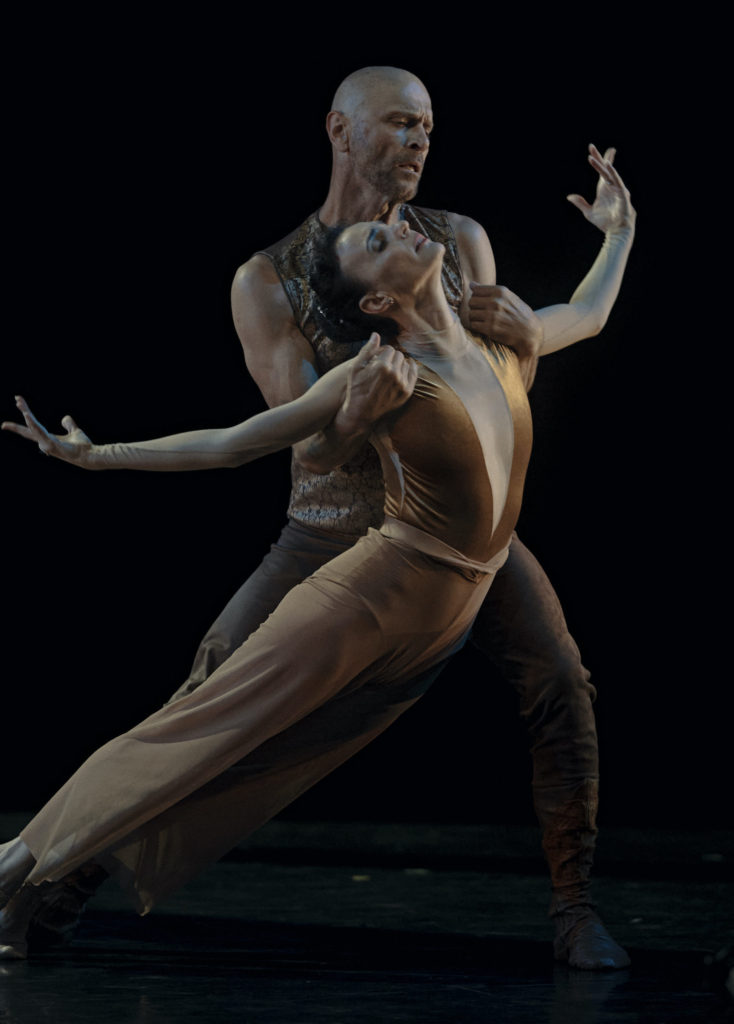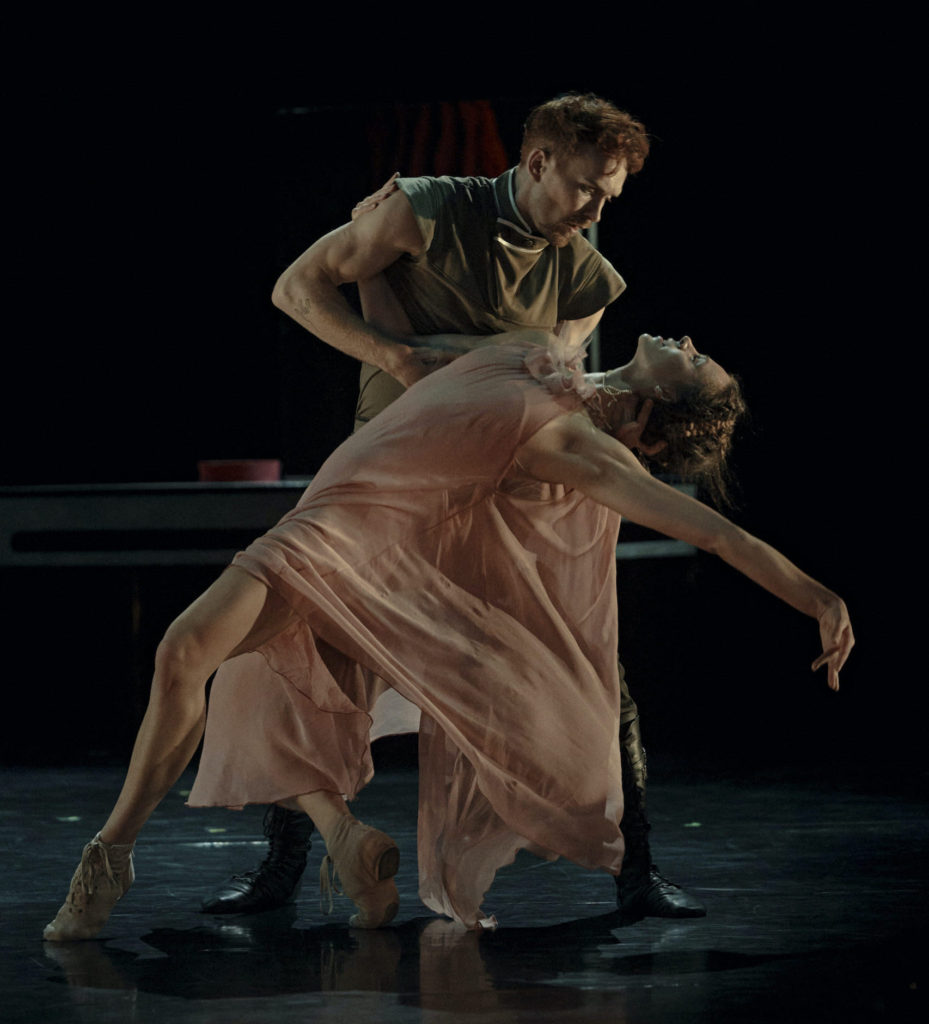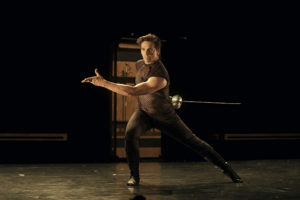Hamlet, First Draft: Guillaume Côté pursues the Prince of Denmark - Vancouver Ballet Society
- Home
- Reviews 2020 - 2023
- Hamlet, First Draft: Guillaume Côté pursues the Prince of Denmark

By Victor Swoboda
Guillaume Côté knows Shakespeare’s Hamlet well. In 2012, he performed the title role in American choreographer Kevin O’Day’s two-hour Hamlet, staged by the National Ballet of Canada, where Côté is a principal dancer. Then he danced the title role in his own short Hamlet Redux, at the 2018 Festival des Arts de St-Sauveur, where he is artistic director. At that time, I wrote in Dance International: “Something tells me that this staging was preliminary to a longer, more comprehensive Côté Hamlet.”
Five years later, at the July 26 opening night of the 2023 festival in St-Sauveur, a short drive north of Montreal, there I was watching the premiere of Côté’s completely new Hamlet, First Draft, running two hours without intermission. Evidently the enigmatic Dane’s personality resonates in Côté.

For this production, the choreographer’s own company, Côté Danse, employed a splendid cast of nine mainly Toronto-based dancers. Stage direction was by the internationally known Quebec director, Robert Lepage, with whom Côté co-created Frame by Frame, a popular 2018 multimedia production for the National Ballet of Canada.
Their new Hamlet, though billed as a first draft, already in its present form made a dramatic impact that often captured the emotional tenor of Shakespeare’s famously complicated play.
In a tent theatre, Lepage obviously did not have access to massive stage machinery as he did for his productions at New York’s Metropolitan Opera or for Cirque du Soleil in Las Vegas. Hamlet, First Draft was staged on a deliberately small scale, ideal for touring. Nevertheless, in many years of attending St-Sauveur performances, I never saw the tent stage look so elegant. Long, low benches were ingeniously arranged and re-arranged according to need, creating a throne, a lady’s vanity, a theatrical stage, a royal bed, and much else.
The curtain opened on a group of dead bodies, a forecast of the tragedy to come. Côté and Lepage took an earnest approach to Shakespeare’s story, eschewing irony or implicit social commentary often seen nowadays in contemporary adaptations of iconic works. Côté’s choreography leaned heavily on balletic athleticism — turns, jumps, lifts, extensions — used purposefully, it must be said, not simply to impress.

Wearing a transparent black shirt and leather vest (costumes were by Monica Onozko), Côté interpreted Hamlet convincingly in all his different moods — brooding, joyful, contemplative, at times vicious and quick with a sword. A virtuoso dancer, his facial expressions and gestures appeared natural, without theatrics.
Côté chose to expand the role of Ophelia (Carleen Zouboules), whose solos and duets with Hamlet, brother Laertes (Lukas Malkowski), and father Polonius (William Yong) tended in the early stages to eclipse the central drama of Hamlet’s revenge against his mother, Queen Gertrude (Greta Hodgkinson, in the role she played in 2018), and his treacherous uncle, King Claudius (Robert Glumbek).
The production did not shy from explicit eroticism. From behind a curtain, Hamlet observed the royal couple’s energetic lovemaking on a brightly lit bed. Later, in an effectively choreographed scene of brutality, Gertrude fell victim to Hamlet’s rage and witnessed the slaying of old Polonius, a sequence ending with mother and son exchanging an incestuous kiss.
Many intelligent touches enlivened the choreography. To illustrate “To be or not to be,” Hamlet angrily brandished a sabre before placing it ominously to his neck. The play-within-a-play sequence featured Hamlet and Horatio (Poon Woo) wearing King and Queen masks on the back of their heads, dancing with backs to the audience and delightful arms-and-legs coordination. The high-kicking prancing of Rosencrantz (Connor Mitton) and Guildenstern (Willem Sadler) merrily illustrated the good cheer and naivety of this fateful couple.
Original music by veteran Toronto composer John Gzowski greatly helped maintain the dramatic momentum. Among an impressive range of musical rhythms was a medieval-sounding pavane, jocular tunes for Rosencrantz and Guildenstern, and spare percussive sounds for Hamlet’s pondering.
During Hamlet’s climactic sword fight with Laertes, when bodies were falling right and left, the dramatic threads became tangled, with a consequent loss of tension. The play ended on a long, strange note, to my mind, with Horatio bemoaning Hamlet’s death by an excess of handwringing.
But this was a work in progress, so final assessment must wait until Hamlet returns, possibly, I was told, next year in Toronto.
Festival des Arts de St-Sauveur continues until August 6: shows and tickets at https://festivaldesarts.ca/en/

